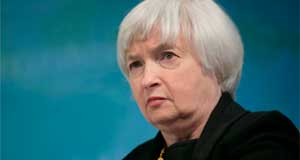 While the main focus this week has been on Fed Chair Janet Yellen’s speech later today, the expectation surrounding it has been out of all proportion to the likely outcome, which in all probability is likely to be fairly benign.
While the main focus this week has been on Fed Chair Janet Yellen’s speech later today, the expectation surrounding it has been out of all proportion to the likely outcome, which in all probability is likely to be fairly benign.
That being said the last two days have seen markets drift lower as low volumes and a lack of positive headlines sees stock markets give up any prospect of a positive week, with the health care sector in particular weighing on sentiment.
As we look ahead to this afternoon’s Jackson Hole speech it would be surprising if Mrs Yellen was either dovish or hawkish, though given the odds currently assigned to the prospect of a move in September the risk is likely to be towards the hawkish side, for no other reason than the Federal Reserve will want to keep markets guessing in the event we see an improvement in the economic data between now and September 21st.
The ability of the Fed to move also continues to be constrained by other central banks and potential future policy moves on their part as they look to ease further, with the Bank of Japan expected to come under further pressure after Japanese CPI fell further into deflationary territory. Some in the markets are slowly coming to the realisation that central bankers the world over are fumbling around in the dark as they try to reinvigorate their economies.
More importantly she will want to give the impression that the Fed does have the tools to cope in what is increasingly looking like a permanently low growth and low interest rate environment.
Before this afternoon’s speech we are expected to get confirmation and some revisions to the latest Q2 GDP numbers from France, the UK and the US.
For France the outlook remains difficult, even though we saw unemployment edge down in data released earlier this week. Its Q2 GDP numbers are expected to be confirmed at 0%, with little or no uplift as a result of the Euro 2016 football championships.
In the UK, we’ve seen a host of better than expected economic data over the past week or so, and while we saw a fairly decent preliminary Q2 GDP number, there is a risk that this might get revised lower, particularly since we did see some evidence of a slowdown in late May and June as the referendum date approached.
This doesn’t appear to be reflected in the forecasts at the moment with GDP expected to be reaffirmed at 0.6%, with both imports and exports expected to improve. The real concern remains around business investment which is expected to decline further from -0.6%, previously to -0.9%. This particular component is likely to be closely monitored over the cause of the next few quarters for evidence as to whether businesses feel confident enough to start hiring and expanding again, though any changes in this regard aren’t likely to be seen in the data for some time.
While the UK economy appears to have defied the worst of the predictions in the aftermath of the Brexit vote there is a concern that any effect could well be more of a slow burn than immediately obvious.
Yesterday’s German IFO business survey would appear to suggest that German businesses are concerned about a slow ripple out effect, as it posted its lowest reading in six months.
In the US the debate about when to raise rates continues after durable goods for July showed an unexpectedly sharp rise of 1.5%, exceeding forecasts though the June numbers were downgraded slightly, however a disappointing August services PMI reading slightly offset that.
Today’s Q2 GDP revision is expected to show a further downgrade from 1.2% to 1.1%, further raising questions as to why initial Q2 expectations were so high in the first place. Initial projections for Q2 were for a number above 2.5%, which subsequently proved wildly optimistic, despite some decent jobs gains in that quarter. Furthermore the mixed data seen thus far in Q3 appears to suggest that the current quarter isn’t likely to be that much better than Q2.
It is this conundrum that continues to cloud the picture for the US economy, an apparently decent jobs market, but shallow economic gains, with manufacturing a particular concern, and the US consumer not particularly keen to spend.
EURUSD – finding support above the 1.1240/50 level for now keeping the prospect of a move towards 1.1400 and the June highs on the table. It seems likely that we will continue to remain range bound with only a move below the 1.1200 area arguing for a move back towards 1.1120.
GBPUSD – starting to look a little heavy after stalling just below 1.3300, with the risk of a move back towards 1.3120, and even 1.3020. We need to push through 1.3300 and trend line resistance there to target 1.3500.
EURGBP – found support at the 0.8490 area, with only a break below targeting 0.8400. A move back through 0.8620 is needed to retarget the highs just above the 0.8700 area.
USDJPY –having found support around the 99.50 area the US dollar needs to see a move back through the 101.30 level to stabilise and mitigate the risk of a move towards the recent lows at 98.95. The risk remains skewed for a move through these lows at 98.90, and potentially lower towards 95.00, and levels last seen in June 2013.












